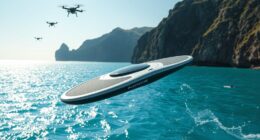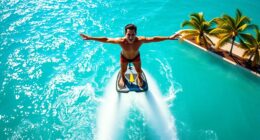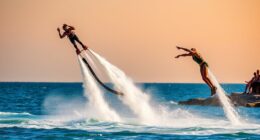Mastering paddling techniques like the forward stroke, sweep stroke, and bracing is essential for an enjoyable kayaking experience. When you perfect the forward stroke, you’ll gain better control and efficiency. The sweep stroke will help you maneuver your kayak with ease, especially during turns. Bracing techniques keep you stable in choppy waters, reducing the chance of capsizing. Get ready to enhance your skills further, as there’s more to learn about improving your kayaking proficiency.
Key Takeaways
- Mastering the forward stroke enhances control, efficiency, and energy usage while paddling.
- The sweep stroke facilitates quick turns by extending the paddle in a wide arc.
- Bracing technique provides stability in turbulent waters, helping prevent capsizing.
- Maintaining a proper paddle grip is crucial for all techniques to ensure control and safety.
- Engaging core muscles during paddling improves overall efficiency and steering responsiveness.

Have you ever wondered how the right paddling techniques can transform your time on the water? Mastering the forward stroke, sweep stroke, and bracing techniques can make all the difference in your kayaking experience. Let’s explore how these techniques can enhance your control and efficiency, especially when it comes to kayak steering.
Mastering key paddling techniques can significantly elevate your kayaking experience by enhancing control and efficiency on the water.
The forward stroke is the fundamental technique every kayaker should perfect. When you maintain a proper paddle grip, you’ll notice how much easier it is to propel yourself forward. Place your hands shoulder-width apart on the paddle, with the knuckles aligned and fingers wrapped securely. As you dip the blade into the water, focus on using your core muscles instead of just your arms. This approach not only saves energy but also allows for better control over your kayak’s direction. You’ll find that engaging your core helps in steering the kayak straight, making your strokes more effective.
Once you’ve got the forward stroke down, it’s time to explore the sweep stroke. This technique is essential for turning your kayak efficiently. To perform the sweep stroke, extend your paddle far out to the side, making a wide arc back towards the kayak. With a proper paddle grip, you’ll find it easier to maintain control as you steer. This stroke is particularly helpful when you need to make sharp turns, whether you’re navigating tight bends or avoiding obstacles in the water. The sweep stroke maximizes your kayak’s responsiveness, allowing for smoother navigation.
Bracing is another indispensable technique that guarantees stability, especially in choppy or turbulent waters. When you feel your kayak tipping, a quick brace can help you regain your balance. To execute a brace, lower your paddle into the water at an angle while leaning into the paddle. This technique aids in kayak steering by providing immediate feedback and support. A good paddle grip will allow you to push against the water effectively, preventing capsizing and making sure that you stay upright. Understanding the importance of stability while paddling can further enhance your safety on the water.
Frequently Asked Questions
What Type of Paddle Is Best for Beginners?
For beginners, a lightweight paddle made from materials like fiberglass or aluminum is best. These options offer durability without being too heavy, making it easier for you to maneuver. You should also consider the paddle length; a longer paddle works well for wider kayaks, while shorter ones suit narrower designs. Finding the right combination of material and length will enhance your paddling experience and help you build confidence on the water.
How Do I Maintain My Paddle for Longevity?
To maintain your paddle for longevity, you’ve gotta treat it right! Ever wondered how a little care can make a big difference? Rinse your paddle with fresh water after each use to remove dirt and salt. Store it in a cool, dry place, avoiding direct sunlight. Regularly check for damage or wear, and don’t forget to apply a protective finish if it’s wooden. These paddle maintenance tips will keep your gear in top shape!
Can I Use a Kayak Paddle for Canoeing?
Yes, you can use a kayak paddle for canoeing, but it’s not ideal. Kayak paddles are usually shorter in length and designed for a different paddling style. If your paddle material is lightweight and durable, it could work for casual trips. However, for better efficiency and comfort, consider using a canoe paddle that’s longer and specifically designed for the stroke style you’ll be using. Enjoy your time on the water!
What Safety Gear Do I Need While Paddling?
You might think you don’t need much safety gear while paddling, but it’s vital for your safety. Start with a personal flotation device (PFD) since it keeps you afloat in emergencies. Always wear a whistle to signal for help, and consider a paddle float for re-entry. A first aid kit and a bilge pump are also essential. By prioritizing these safety gear essentials, you’ll enjoy your time on the water with peace of mind.
How Do Weather Conditions Affect Paddling Techniques?
Weather conditions considerably impact your paddling experience. Strong winds can make navigation tricky, pushing you off course and requiring more effort to maintain stability. You’ll need to adjust your strokes to compensate for wind direction, using techniques that help you stay on track. Rain can reduce visibility and affect water currents, so stay alert. Always check the forecast before heading out, ensuring you’re prepared for any weather-related challenges you might face.
Conclusion
Mastering paddling techniques like the forward stroke, sweep stroke, and bracing is like learning the dance of the water. Each stroke flows into the next, creating a harmonious rhythm that keeps you in sync with your kayak. Embrace these techniques, and you’ll navigate the waves with confidence and grace. So, whether you’re slicing through calm waters or maneuvering around obstacles, remember: every stroke you take brings you closer to becoming one with the water.










